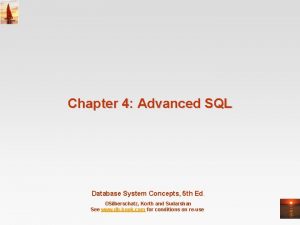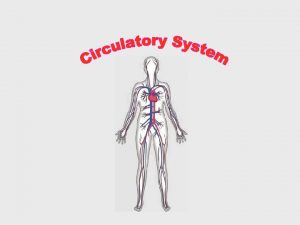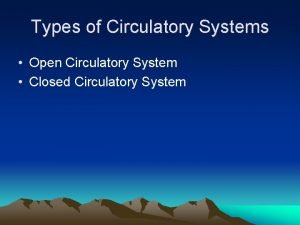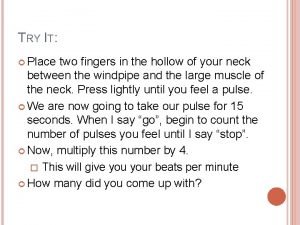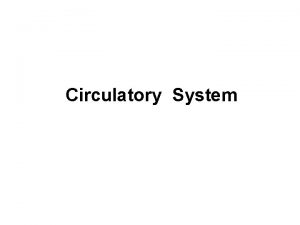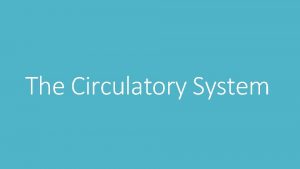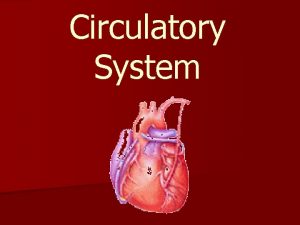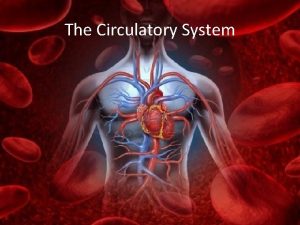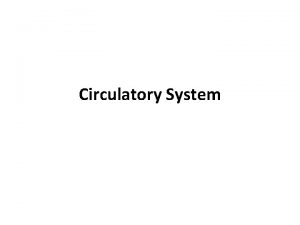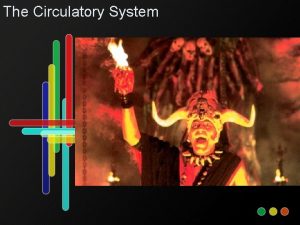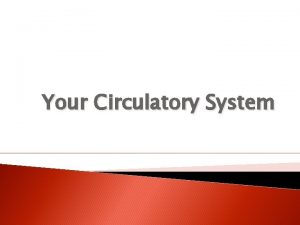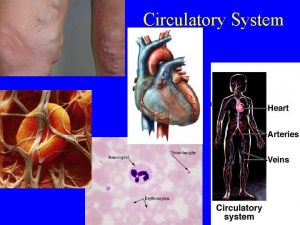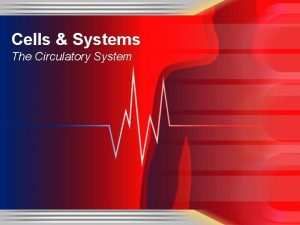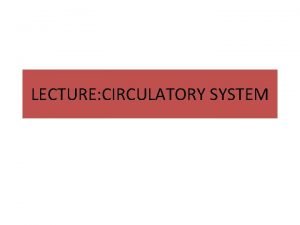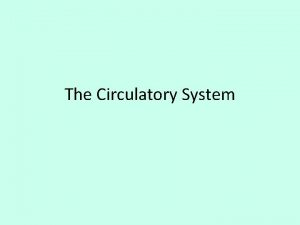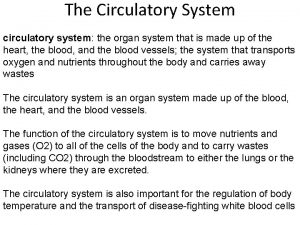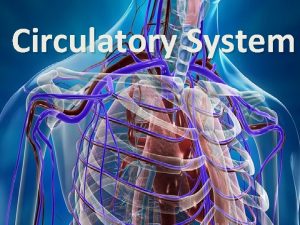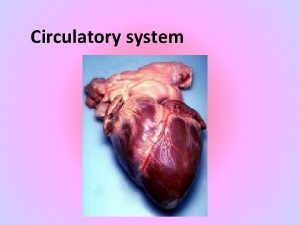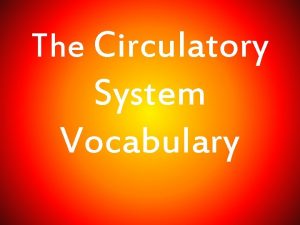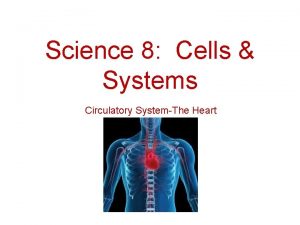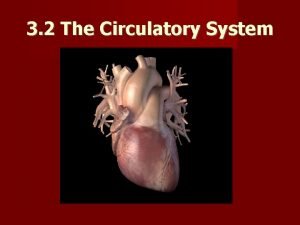THE CIRCULATORY SYSTEM Circulatory System Provides cells with


























- Slides: 26

THE CIRCULATORY SYSTEM

Circulatory System � Provides cells with oxygen and nutrients and removes wastes � Includes the heart, several kilometers of blood vessels, and blood

How do materials move in and out of cells? (2 ways)

Movement of materials � Diffusion: material moves to area where there is less of it (no energy needed) � Active transport: uses energy to move material to an area even though there might already be a lot of that material there

What is the role of blood vessels?

Blood vessels � Carry blood to and from the heart � Blood moving away from the heart: full of oxygen and nutrients � Blood moving back to the heart: full of carbon dioxide and wastes

Blood vessels � Like a one-way street: blood only moves in one direction � 3 types of blood vessels: can you name them? � Hint: one carries blood to heart, one carries blood away from heart, and one connects them

Blood vessels � Arteries: carry blood away from the heart � Thick, � � elastic walls Veins: carry blood back to the heart Capillaries: microscopic blood vessels that connect arteries and veins � Walls are only one cell thick (allows for nutrients and oxygen to diffuse out of capillaries and carbon dioxide and waste to diffuse back into capillaries) � Every cell is within 0. 15 mm of a capillary

What is the main organ of the circulatory system?

The Heart

The Heart � � Made of four compartments (chambers) Upper chambers: atriums Lower chambers: ventricles Blood flows from left atrium to left ventricle, and right atrium to right ventricle, but not between right and left chambers � One side has oxygen-rich blood and one side has blood with very little oxygen

3 sections of circulatory system � Coronary circulation � Pulmonary circulation � Systemic circulation

Blood Flow � All are controlled by the beating of your heart � One heartbeat: both atriums contract at same time, then both ventricles contract at same time � Blood flow: one atrium to one ventricle to an artery

Coronary Circulation � Flow of blood to and from tissues of the heart � The heart, like any other muscle, needs blood vessels � Supply it with nutrients and oxygen � Remove wastes and carbon dioxide � If coronary arteries become damaged, it can lead to heart attacks

Pulmonary Circulation � � Flow of blood through the heart, to the lungs, and back to the heart Blood returning to the heart enters the right atrium (think Right = Return) � Enters through 2 main veins: superior and interior vena cava Superior vena cava: returns blood from head and neck Inferior vena cava: returns blood from lower body � Blood � is high in carbon dioxide and low in oxygen Right atrium contracts and forces blood down into right ventricle

Pulmonary Circulation � � � Right ventricle contracts, forcing blood out of heart and into pulmonary artery Pulmonary artery carries blood to lungs, where is exchanges carbon dioxide for oxygen Pulmonary vein carries oxygen-rich blood from lungs back to heart, where is enters through left atrium Left atrium contracts and forces blood down into left ventricle Left ventricle contracts and forces blood out of heart and into aorta (main artery)

Systemic Circulation � � Oxygen-rich blood flows to organs and body tissues, and oxygen-poor blood returns to the heart Largest of the three parts of the circulatory system Oxygen-rich blood exits left ventricle, enters aorta, and is taken throughout body by arteries and capillaries Oxygen-poor blood is taken back to heart by veins, then superior and inferior vena cava take this blood to heart’s right atrium

If you fill a balloon with water and push down on it, what happens?

It puts pressure on the walls of the balloon

Blood pressure � � Your blood puts pressure on the walls of the blood vessels too Blood pressure: the force of the blood on the walls of the blood vessels � Highest � in arteries, lowest in veins Measured in large arteries by 2 numbers � Systolic: top number, when ventricles contract and blood is pushed out of heart � Diastolic: bottom number, occurs as ventricles fill with blood just before they contract � Sample blood pressure: 120 over 80

Blood pressure � Your body wants to keep it normal to keep blood reaching all organs � When blood pressure changes and falls out of a normal range, nerves send messages to the brain to adjust this by speeding up or slowing down the heart rate

What is the leading cause of death in the United States?

Heart disease � � Also called cardiovascular disease Common types of heart disease: � Hypertension � Heart failure � Stroke � Athersclerosis � Heart attack

Your assignment � � � With a partner, you will research one of the common heart diseases on the previous slide Be prepared to explain to the class what exactly happens to the heart, what may cause it, what risks are associated, and what can be done to avoid it Other factors to consider: is it related to another disease? Does it cause death or another illness? How many people does it kill annually?

Heart Disease � Atherosclerosis: fatty deposits build up on walls of arteries, and blood can’t get through � Comes from eating foods high in cholesterol and saturated fats � See p. 236

Heart Disease continued � Hypertension: high blood pressure for an extended period of time � Puts extra strain on your heart to get nutrients and oxygen to all the body’s cells � Can be caused by atherosclerosis
 Digestive system circulatory system and respiratory system
Digestive system circulatory system and respiratory system Onodi cells and haller cells
Onodi cells and haller cells Dr saja
Dr saja Thyroid parafollicular cells
Thyroid parafollicular cells Somatic vs gamete
Somatic vs gamete Why dna is more stable than rna
Why dna is more stable than rna Red blood cells and white blood cells difference
Red blood cells and white blood cells difference Eukaryotic vs prokaryotic cells
Eukaryotic vs prokaryotic cells Similarities between plant and animal cells venn diagram
Similarities between plant and animal cells venn diagram Prokaryotic vs eukaryotic cells venn diagram
Prokaryotic vs eukaryotic cells venn diagram Why did robert hooke name cells “cells”?
Why did robert hooke name cells “cells”? Masses of cells form and steal nutrients from healthy cells
Masses of cells form and steal nutrients from healthy cells Label
Label Are plant cells prokaryotic or eukaryotic
Are plant cells prokaryotic or eukaryotic Prokaryotic cells
Prokaryotic cells Chapter 8 cellular reproduction cells from cells
Chapter 8 cellular reproduction cells from cells Cell substance
Cell substance How respiratory system work with circulatory system
How respiratory system work with circulatory system Circulatory system and respiratory system work together
Circulatory system and respiratory system work together An operating system is an interface between
An operating system is an interface between Each database system supporting odbc provides
Each database system supporting odbc provides Each database system supporting odbc provides a/an
Each database system supporting odbc provides a/an Circulatory system steps in order
Circulatory system steps in order Single loop circulatory system
Single loop circulatory system Lungfish circulatory system
Lungfish circulatory system Do clams have an open or closed circulatory system
Do clams have an open or closed circulatory system Circulatory system of a cow
Circulatory system of a cow





















